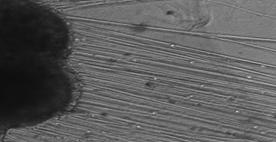Spinal Cord Transplant and Peripheral NerveTransplant
SPINAL CORD TRANSPLANT - There are an estimated 10,000 patients who suffer spinal cord injury (SCI) each year in the United States and approximately 250,000 chronic SCI patients. Accordingly, there are extensive research efforts to develop techniques that enhance axon growth in the injured spinal cord. A primary goal of these efforts is to promote axon growth across the lesion to integrate with viable tissue on either side and create functional relays.
There have been numerous notable attempts at promoting axon bridges across spinal cord lesions. Some of the previous techniques have been successful in promoting axon sprouting into or around spinal cord lesions in animal models. While promising, this sprouting typically includes only a small number of spinal axons growing a limited distance. It has been proposed that the improvements in functional recovery often found after SCI in these transplanted animals is primarily due to physical and biochemical support for the host tissue surrounding the lesion, rather than the formation of new intraspinal circuits across the lesion. Considering that human SCI lesions typically extend several centimeters, bridging these lesions with axons of sufficient number and length to form functional relays remains an enormous challenge.
In contrast to inducing axon growth by promoting sprouting of axons, researchers have recently developed technology that induces rapid axon growth through continuous mechanical elongation of integrated axon tracts in vitro (Smith et al., 2001; Pfister et al., 2004). This axon stretch-growth technology was recently adapted to create nerve constructs consisting of living and functional axon tracts that are capable of bridging even extensive SCI lesions (Figure: Illustration of the SCI transplant). Most recently, it was found that transplanted elongated cultures from GFP transgenic rats survived four weeks in the injured spinal cord (Figure: Survival of transplanted tissues). These results demonstrate the promise of the lab’s nerve constructs consisting of stretch-grown axons to bridge even extensive spinal cord lesions. The research team is now investigating the functional recovery after SCI in the transplanted animals.
 PERIPHERAL NERVE TRANSPLANT - Traditional methods for repairing peripheral nerve deficits include bridging the nerve gap with an autologous graft or a bioabsorbable tube. The autologous graft is considered the gold standard for repair of significant lesions within the PNS, but its challenges include the limited supply of donor nerves and donor site morbidity. Researchers sought to test a new concept in which living dorsal root ganglion neurons and mechanically stretch-grown axons are transplanted into a 12mm sciatic nerve gap in the rat.
PERIPHERAL NERVE TRANSPLANT - Traditional methods for repairing peripheral nerve deficits include bridging the nerve gap with an autologous graft or a bioabsorbable tube. The autologous graft is considered the gold standard for repair of significant lesions within the PNS, but its challenges include the limited supply of donor nerves and donor site morbidity. Researchers sought to test a new concept in which living dorsal root ganglion neurons and mechanically stretch-grown axons are transplanted into a 12mm sciatic nerve gap in the rat.


